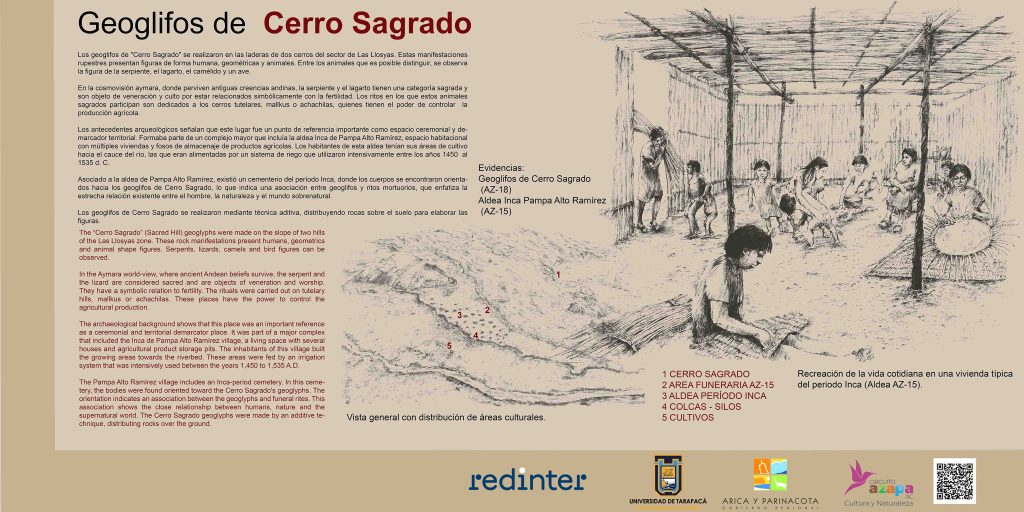Geoglifos de “Cerro Sagrado” (“Cerro Sagrado” geoglyph)
Geoglifos de “Cerro Sagrado”
km 8 – 9,5 Ruta A-133
(19 K 370381.00 m E 7951033.00 m N)
Evidencias:
-Geoglifos de Cerro Sagrado (AZ-18)
-Aldea Inca Pampa Alto Ramírez (AZ-15)
“Cerro Sagrado” geoglyph
Km 8 – 9.5 Route A-133
(19 K 370381.00 m E 7951033.00 m N)
Evidences:
-Cerro Sagrado geoglyphs (AZ-18)
-Inca Pampa Alto Ramírez village (AZ-15)
Los geoglifos de “Cerro Sagrado” se realizaron en las laderas de dos cerros del sector de Las Llosyas (“lloclla”, bajada de agua violenta en aymara). Estas manifestaciones rupestres presentan figuras de forma humana, geométricas y animales. Entre los animales que es posible distinguir, se observa la figura de la serpiente, el lagarto, el camélido y un ave.
En la cosmovisión aymara, donde perviven antiguas creencias andinas, la serpiente y el lagarto tienen una categoría sagrada y son objeto de veneración y culto por estar relacionados simbólicamente con la fertilidad. Los ritos en los que estos animales sagrados participan son dedicados a los cerros tutelares, mallkus o achachilas, quienes tienen el poder de controlar la producción agrícola.
Los antecedentes arqueológicos señalan que este lugar fue un punto de referencia importante como espacio ceremonial y demarcador territorial. Formaba parte de un complejo mayor que incluía la aldea Inca de Pampa Alto Ramírez, espacio habitacional con múltiples viviendas y fosos de almacenaje de productos agrícolas. Los habitantes de esta aldea tenían sus áreas de cultivo hacia el cauce del río, las que eran alimentadas por un sistema de riego que utilizaron intensivamente entre los años 1450 al 1535 d. C.
Asociado a la aldea de Pampa Alto Ramírez, existió un cementerio del período Inca, donde los cuerpos se encontraron orientados hacia los geoglifos de Cerro Sagrado, lo que indica una asociación entre geoglifos y ritos mortuorios, que enfatiza la estrecha relación existente entre el hombre, la naturaleza y el mundo sobrenatural.
The “Cerro Sagrado” (Sacred Hill) geoglyphs were made on the slope of two hills of the Las Llosyas zone. These rock manifestations present humans, geometrics and animal shape figures. Serpents, lizards, camels and bird figures can be observed.
In the Aymara world-view, where ancient Andean beliefs survive, the serpent and the lizard are considered sacred and are objects of veneration and worship. They have a symbolic relation to fertility. The rituals were carried out on tutelary hills, mallkus or achachilas. These places have the power to control the agricultural production.
The archaeological background shows that this place was an important reference as a ceremonial and territorial demarcator place. It was part of a major complex that included the Inca de Pampa Alto Ramírez village, a living space with several houses and agricultural product storage pits. The inhabitants of this village built the growing areas towards the riverbed. These areas were fed by an irrigation system that was intensively used between the years 1,450 to 1,535 A.D.
The Pampa Alto Ramírez village includes an Inca-period cemetery. In this cemetery, the bodies were found oriented toward the Cerro Sagrado’s geoglyphs. The orientation indicates an association between the geoglyphs and funeral rites. This association shows the close relationship between humans, nature and the supernatural world.
The Cerro Sagrado geoglyphs were made by an additive technique, distributing rocks over the ground.
